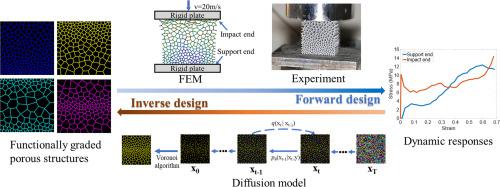当前位置:
X-MOL 学术
›
Int. J. Mech. Sci.
›
论文详情
Our official English website, www.x-mol.net, welcomes your feedback! (Note: you will need to create a separate account there.)
Inverse design of functionally graded porous structures with target dynamic responses
International Journal of Mechanical Sciences ( IF 7.1 ) Pub Date : 2024-07-04 , DOI: 10.1016/j.ijmecsci.2024.109530 Zhiqiang Zou , Jinlong Liu , Kang Gao , Da Chen , Jie Yang , Zhangming Wu
International Journal of Mechanical Sciences ( IF 7.1 ) Pub Date : 2024-07-04 , DOI: 10.1016/j.ijmecsci.2024.109530 Zhiqiang Zou , Jinlong Liu , Kang Gao , Da Chen , Jie Yang , Zhangming Wu

|
Although functionally graded porous structures (FGPS) have been studied comprehensively due to their excellent mechanical and functional properties, the design process of FGPS with target stress response still dependent on continuous trial and error, which is not only time-consuming but also heavily relies on experience and intuition. This study proposes a novel inverse design framework of 2D FGPS with targeted dynamic stress-strain responses via a combination of conditional diffusion model and a residual neural network. Unlike traditional binary pixel representations, this approach utilizes nuclei position maps and color mapping technique to represent the structure configurations and cell wall thicknesses to improve the efficiency and performance of the model. Firstly, various functionally graded porous structures were constructed by employing Voronoi diagram techniques, and finite element simulations were conducted to calculate the nonlinear responses subjected to dynamic loadings. A dataset comprising 2100 FGPS and corresponding nonlinear stress-strain responses was established. Then, an inverse design framework is formulated by integrating a generator that uses a diffusion model to synthesize structures conditioned on specific target responses, with a predictor that employs a residual neural network to assess the responses of these structures. Finally, to demonstrate the effectiveness of the approach, the performance of the predictor and generator was thoroughly investigated. Structures with various target stress-strain responses were generated through the proposed method, and validated by finite element analysis. A detailed impact experiment was also carried out to verify the effectiveness of the proposed methods. The result shows that the framework can effectively generate new structures with objective nonlinear responses. This work offers a fast and efficient way to design FGPS that meet specific performance objectives.
中文翻译:

具有目标动态响应的功能梯度多孔结构的逆向设计
尽管功能梯度多孔结构(FGPS)因其优异的力学和功能特性而得到了全面的研究,但具有目标应力响应的FGPS的设计过程仍然依赖于不断的试错,这不仅耗时,而且严重依赖于经验和直觉。本研究提出了一种新颖的 2D FGPS 逆向设计框架,通过条件扩散模型和残差神经网络的组合来实现目标动态应力应变响应。与传统的二值像素表示不同,该方法利用核位置图和颜色映射技术来表示结构配置和细胞壁厚度,以提高模型的效率和性能。首先,采用Voronoi图技术构建各种功能梯度多孔结构,并进行有限元模拟来计算动态载荷下的非线性响应。建立了包含 2100 个 FGPS 和相应的非线性应力应变响应的数据集。然后,通过集成使用扩散模型来合成以特定目标响应为条件的结构的生成器和使用残差神经网络来评估这些结构的响应的预测器,从而制定逆向设计框架。最后,为了证明该方法的有效性,对预测器和生成器的性能进行了彻底研究。通过所提出的方法生成具有各种目标应力应变响应的结构,并通过有限元分析进行验证。还进行了详细的冲击实验以验证所提出方法的有效性。 结果表明,该框架可以有效地生成具有客观非线性响应的新结构。这项工作提供了一种快速有效的方法来设计满足特定性能目标的 FGPS。
更新日期:2024-07-04
中文翻译:

具有目标动态响应的功能梯度多孔结构的逆向设计
尽管功能梯度多孔结构(FGPS)因其优异的力学和功能特性而得到了全面的研究,但具有目标应力响应的FGPS的设计过程仍然依赖于不断的试错,这不仅耗时,而且严重依赖于经验和直觉。本研究提出了一种新颖的 2D FGPS 逆向设计框架,通过条件扩散模型和残差神经网络的组合来实现目标动态应力应变响应。与传统的二值像素表示不同,该方法利用核位置图和颜色映射技术来表示结构配置和细胞壁厚度,以提高模型的效率和性能。首先,采用Voronoi图技术构建各种功能梯度多孔结构,并进行有限元模拟来计算动态载荷下的非线性响应。建立了包含 2100 个 FGPS 和相应的非线性应力应变响应的数据集。然后,通过集成使用扩散模型来合成以特定目标响应为条件的结构的生成器和使用残差神经网络来评估这些结构的响应的预测器,从而制定逆向设计框架。最后,为了证明该方法的有效性,对预测器和生成器的性能进行了彻底研究。通过所提出的方法生成具有各种目标应力应变响应的结构,并通过有限元分析进行验证。还进行了详细的冲击实验以验证所提出方法的有效性。 结果表明,该框架可以有效地生成具有客观非线性响应的新结构。这项工作提供了一种快速有效的方法来设计满足特定性能目标的 FGPS。












































 京公网安备 11010802027423号
京公网安备 11010802027423号